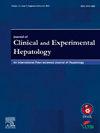Splenic Artery Embolization in Living Donor Liver Transplant Recipients: Indications, Safety and Clinical Outcomes
IF 3.3
Q2 GASTROENTEROLOGY & HEPATOLOGY
Journal of Clinical and Experimental Hepatology
Pub Date : 2025-02-04
DOI:10.1016/j.jceh.2025.102510
引用次数: 0
Abstract
Purpose
Splenic artery embolization (SAE) is a minimally invasive interventional radiology (IR) procedure that plays an important role in the management of complications in a certain subgroup of liver transplant recipients. SAE is technically of two types – proximal (P-SAE) and distal (D-SAE). There is limited data regarding the role of SAE in liver transplant recipients. The purpose of this study was to describe the role and outcomes of SAE in LDLT recipients based on the indications and the type of procedure used.
Material and methods
Twenty-seven consecutive patients who underwent SAE after LDLT at our institute were retrospectively reviewed. Patients were categorized into two groups – those who underwent P-SAE (n = 7) and D-SAE (n = 20). The embolic agents used were coils or plugs in the P-SAE group; and poly vinyl alcohol (PVA) particles in the D-SAE group.
Results
The median follow-up of the study population was 101 days. The mean platelet and lymphocyte counts improved markedly after SAE (P < 0.001 & P < 0.0001, respectively). Refractory ascites was significantly reduced in both the groups (100% in P-SAE & 77.7% in D-SAE). Minor complications were noted in 28.5% in the P-SAE group and 65% in the D-SAE group. Major complications occurred only in the D-SAE group (15%).
Conclusion
Our results support the use of P-SAE for the management of splenic artery steal and small-for-size graft syndromes; and D-SAE for the management of hypersplenism and refractory ascites. Both procedures are safe and effective and the decision to perform proximal or distal SAE should be based on the indications.

活体肝移植受者脾动脉栓塞:适应症、安全性和临床结果
目的脾动脉栓塞术(SAE)是一种微创介入放射学(IR)手术,在处理肝移植受者并发症中起着重要作用。SAE在技术上分为两种类型-近端(P-SAE)和远端(D-SAE)。关于SAE在肝移植受者中的作用的数据有限。本研究的目的是根据适应症和手术类型描述SAE在LDLT受者中的作用和结果。材料与方法对我院连续27例LDLT术后行SAE的患者进行回顾性分析。患者分为两组-接受P-SAE (n = 7)和D-SAE (n = 20)。P-SAE组栓塞剂为线圈或栓子;D-SAE组中的聚乙烯醇(PVA)颗粒。结果研究人群的中位随访时间为101天。SAE后平均血小板和淋巴细胞计数明显改善(P <;0.001,P & lt;分别为0.0001)。两组难治性腹水均显著减少(P-SAE组100%;77.7%为D-SAE)。P-SAE组的轻微并发症发生率为28.5%,D-SAE组为65%。主要并发症仅发生在D-SAE组(15%)。结论本研究结果支持P-SAE治疗脾动脉窃血和小尺寸移植物综合征;D-SAE用于治疗脾功能亢进和难治性腹水。这两种手术都是安全有效的,进行近端或远端SAE的决定应基于适应症。
本文章由计算机程序翻译,如有差异,请以英文原文为准。
求助全文
约1分钟内获得全文
求助全文
来源期刊

Journal of Clinical and Experimental Hepatology
GASTROENTEROLOGY & HEPATOLOGY-
CiteScore
4.90
自引率
16.70%
发文量
537
审稿时长
64 days
 求助内容:
求助内容: 应助结果提醒方式:
应助结果提醒方式:


